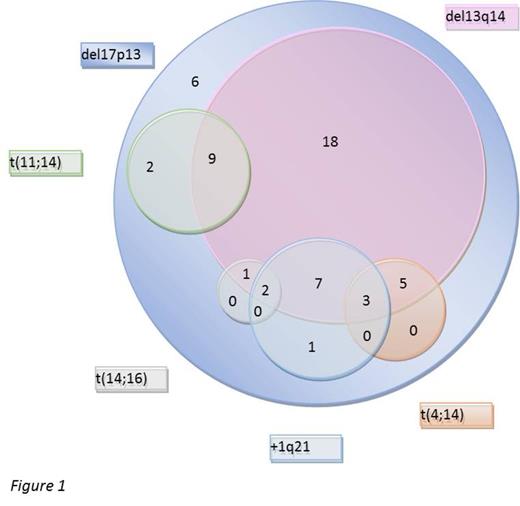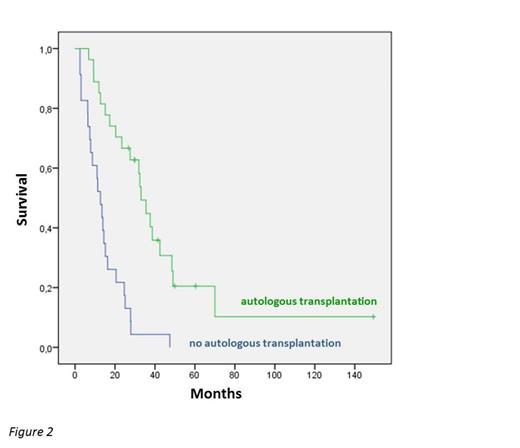Abstract
Introduction: During the last decade, the outcome of patients (pts) with symptomatic multiple myeloma (MM) has markedly improved. However, there is still a significant proportion of pts who do not achieve a longtime control of their disease. In particular, pts presenting with a deletion 17p (del17p) still have dismal prognosis. In order to better stratify this important group of MM pts we sought to investigate the prognostic impact of the following parameters in a larger cohort of del17p pts: del17p clone size, concomitant genetic abnormalities, treatment modalities and the incorporation of the novel agents lenalidomide and bortezomib.
Methods: We identified 54 MM pts diagnosed between 1998 – 2012 who had a del17p at diagnosis and were treated at the University Hospital of Ulm. The patients were screened for additional chromosomal aberrations by fluorescence in situ hybridization (FISH) performed on purified bone marrow plasma cells.
Results: The median age at MM diagnosis was 59 years and the proportion of male pts was 52%. At presentation the median del17p clone size was 83% (range: 28%-98%). In the vast majority of cases (83%) the presence of a del17p was associated with the presence of a del13q14. Other concomitant genetic abnormalities detected by FISH were t(4;14) in 17%, t(11;14) in 30% and gain at 1q21 (+1q21) in 31% of cases (figure 1 ). The median overall survival (OS) was poor (18.9 months) and did not change substantially over time (similar median survival in pts diagnosed before 2006 versus pts diagnosed thereafter). The del17p clone size had no impact on OS, neither the presence of a t(4;14) or a t(11;14). In patients with an additional +1q21 OS was significantly shorter (15.2 versus (v) 32.4 months; p=0,032). The incorporation of one of the novel agents into first-line treatment did not change the outcome significantly. In contrast, pts receiving at least one autologous transplantation showed a significantly longer OS (33.1 v 12.7 months; figure 2 ). On univariate analysis there was an improved median OS for pts undergoing an allogeneic transplantation (n=15; 32.4 v 14.4 months; p=0.025). In multivariate analysis ISS stage and the implementation of an autologous transplantation remained significant prognostic factors for OS.
Conclusions: The outcome of MM pts with a del17p remains poor, even after the introduction of lenalidomide and bortezomib into clinical practice. The development of novel therapeutic strategies therefore is urgently warranted.
No relevant conflicts of interest to declare.
Author notes
Asterisk with author names denotes non-ASH members.



